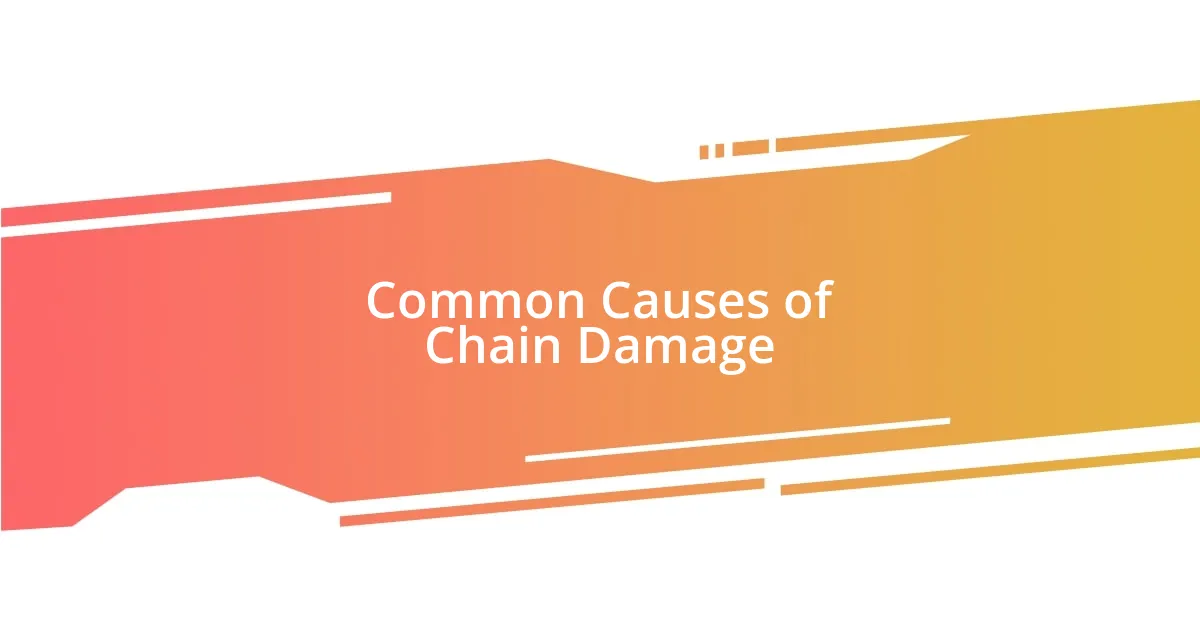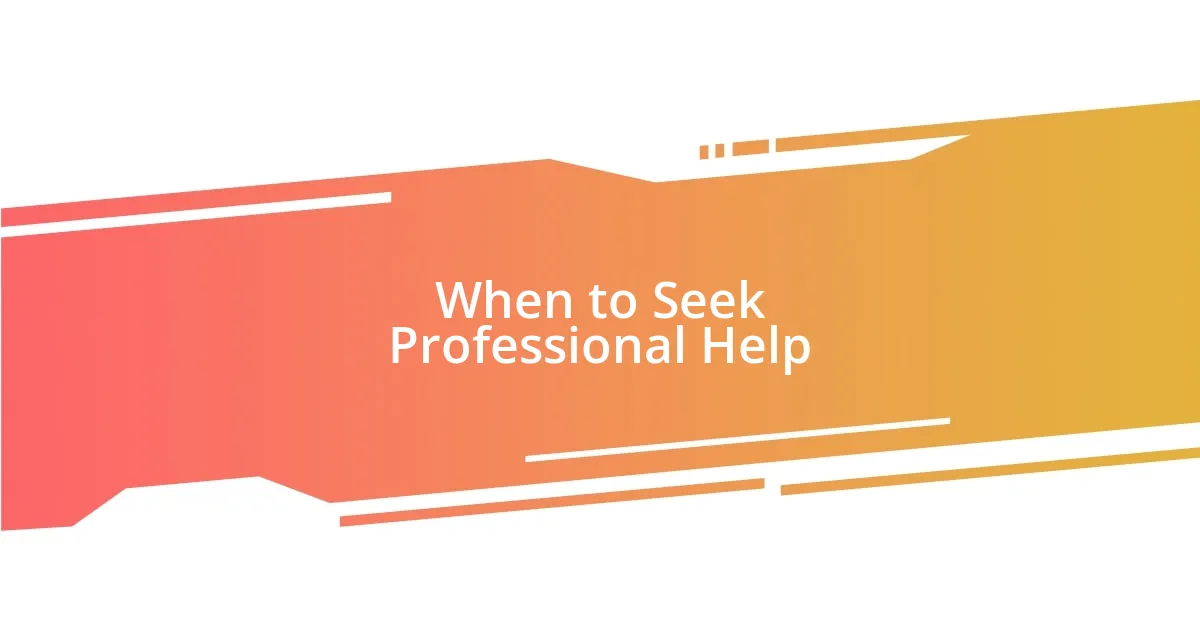Key takeaways:
- Understanding the anatomy and maintenance of chains is crucial for effective repairs and preventing future breakages.
- Regular checks for alignment, lubrication, and cleanliness can significantly extend the lifespan of your chain.
- Having the right tools, such as a chain breaker and lubricant, is essential for efficient chain repairs.
- Knowing when to consult a professional can save you from more extensive damage and costly repairs.

Understanding Chain Repair Basics
When it comes to repairing a broken chain, understanding the anatomy of the chain itself is key. I remember the first time I encountered a snapped chain during a ride; my heart dropped, but I quickly realized it was just a matter of knowing where to start. Every link plays a role, and recognizing the different components helps demystify the repair process.
One crucial aspect I learned is that there are various types of chains, such as roller chains and bicycle chains, each requiring specific tools and techniques. Have you ever thought about how a simple missing link can derail your entire day? I once had to improvise with a pair of pliers on a rainy afternoon, and it taught me the importance of being prepared with the right tools—because the right equipment can make or break your repair experience.
Lastly, consider the tension and alignment of the chain after your repair; it’s essential for smooth operation. I’ve faced frustrating moments where I thought I repaired it perfectly, only to find the chain skip or jam later. This taught me to take my time, double-check my work, and ensure everything is just right before getting back on the road. Paying attention to these details not only enhances performance but also gives you confidence in your repair skills.

Common Causes of Chain Damage
Recognizing the common causes of chain damage can save you a lot of headaches down the road. I remember once during a casual ride, I hit a pothole unexpectedly, and that jarring impact was enough to misalign the chain. It felt like all my careful maintenance had gone to waste in a single moment. Whether it’s poor maintenance or external factors, chains can be vulnerable to several issues.
Here are some of the most frequent culprits of chain damage:
- Misalignment: Chains need to be properly aligned with the sprockets, or else they can wear unevenly or snap.
- Lack of lubrication: A dry chain can lead to excessive friction, increasing the likelihood of breakages.
- Corrosion: Rust from exposure to moisture can weaken the integrity of the link, making it more susceptible to snapping.
- Overloading: Putting too much strain on a chain, whether through heavy loads or aggressive pedaling, can lead to premature failure.
- Debris buildup: Dirt, grime, or even small rocks can get caught in the chain, disrupting its function and causing damage over time.
I’ve found that checking your chain regularly and addressing these issues proactively can really extend its lifespan—and save you from frustrating repairs at inconvenient times.

Tools Needed for Chain Repair
When it comes to repairing a broken chain, having the right tools is essential for getting the job done efficiently. I remember the frustration of trying to fix a chain with just a wrench, realizing mid-repair that I was missing the crucial link tool. A chain breaker, which allows you to push pins out and reconnect links, is arguably a must-have. I’ve often found that having a multi-tool with a chain tool function can save space while still covering all bases, making my repairs simpler and less stressful.
In addition to the chain breaker, I’ve learned that pliers can come in handy for various tasks, especially when working with stubborn links. Sometimes, a gentle squeeze and twist was all it took to free up a rusted section. I’ve also found that a good set of protective gloves can enhance your grip and keep your hands clean—an underrated aspect of the repair process that really matters when you’re out on a ride.
Lastly, don’t underestimate the importance of lubricant. After a repair, applying a quality lubricant not only helps in smooth operation but prolongs the life of your chain. I’ll never forget the first time I skipped this step and my freshly repaired chain began to creak and snag—it served as a valuable lesson about the finishing touches that can make all the difference in your repair experience.
| Tool | Description |
|---|---|
| Chain Breaker | Essential for removing and rejoining chain links |
| Pliers | Useful for gripping and manipulating links |
| Multi-Tool | An all-in-one solution for various bike repairs, including the chain |
| Lubricant | Reduces friction and leads to smoother operation post-repair |
| Protective Gloves | Improves grip and keeps hands clean during repairs |

Tips for Preventing Chain Breaks
When it comes to preventing chain breaks, regular maintenance should be your best friend. I remember that feeling of dread when I realized my chain was dry during a ride; it was a harsh wake-up call. Making it a habit to inspect and lubricate your chain can work wonders. Have you ever considered how a few extra minutes could save you hours of frustration later? I learned the hard way that neglecting this step can lead to catastrophic failures at the most inconvenient times.
Another tip I’ve found invaluable is ensuring proper alignment. It’s astonishing how a slight misalignment can drastically affect the longevity of a chain. I once adjusted my chain tension only to notice it was still off—my ride was a constant reminder that I had to get it right. Taking the extra time to check your alignment doesn’t just enhance performance; it’s a safety measure that can save your chain from unnecessary wear and tear.
Finally, be mindful of how much weight you’re putting on your chain. I once overloaded my bike during a camping trip, thinking it could handle it all. The regrettable snap of that chain was an instant reminder that less can truly be more in certain situations. What are you carrying on your bike? By knowing your limits, you can extend the life of your chain significantly and enjoy a smoother ride.

Maintaining Your Chain for Longevity
One of the key aspects of maintaining your chain for longevity is keeping it clean. I still remember the time I was out on a muddy trail, feeling like a kid again, but my chain was anything but happy. After that ride, I spent way too long trying to scrub away layers of dirt and grime. It’s really amazing how just a quick wipe-down after every ride can prevent that build-up and extend your chain’s life. Have you ever noticed how good maintenance can turn a daunting task into a quick routine?
Another important habit I’ve developed is ensuring the chain is lubricated regularly. The first time I neglected this, I could hear the grinding noise echoing through my ride—it was a screeching reminder that I had cut corners. Now, I make it a point to apply lubricant at least once a month, or after wet rides. You’d be surprised by how much smoother and more efficient your bike runs with just a little lubrication. It’s almost like giving your bike a little TLC; it truly appreciates it!
Lastly, I can’t stress enough the importance of storing your bike correctly. I had this experience where I was rushing to stash my bike in the garage, not realizing I had left it in a damp spot. You can guess what happened! When I went to use it, the chain had rusted and lost its integrity. I’ve learned to always hang my bike or keep it in a dry, sheltered space. Where do you keep your bike? Giving it a safe home can save you from unexpected repairs down the road.

When to Seek Professional Help
Knowing when to seek professional help with your chain can be a tough call. I remember the day I was tinkering with my own bike and thought I could handle a major link repair. But when I noticed that one of the links was completely bent, I felt a wave of uncertainty wash over me. At that moment, I realized that sometimes, letting a pro step in is the wisest choice. Have you ever been in a situation where you hesitated, thinking you could fix it yourself but ended up in a bigger mess?
If you find your chain repeatedly breaking or struggling to shift gears smoothly, it might signal more than just a simple fix. I once had a friend who faced this issue and kept trying to adjust it, thinking he could sort it out. Sadly, it only led to further damage, which ultimately required more costly professional repairs. Don’t wait until small problems escalate; a timely visit to a professional can save you from frustration and unexpected expenses later.
There are moments when the tools you have just aren’t enough. I recall the time I attempted to repair my chain with only a pair of pliers and a general understanding of mechanics. Let’s just say it didn’t end well, and I had to call for backup. If you’re unsure of your repair skills or the right techniques, consider reaching out to a professional. Trust me, a little expert guidance can restore your confidence and keep your bike running smoothly!















